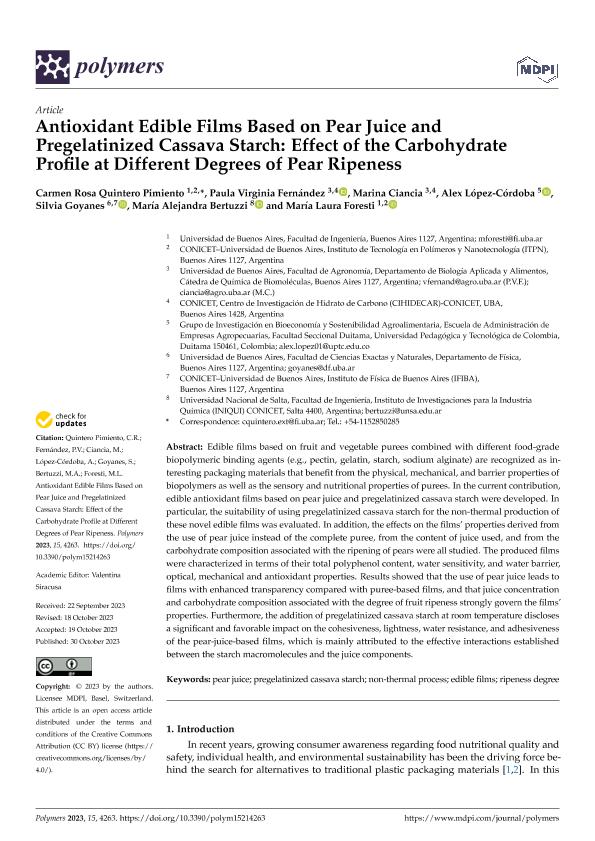Mostrar el registro sencillo del ítem
dc.contributor.author
Quintero Pimiento, Carmen Rosa

dc.contributor.author
Fernández, Paula Virginia

dc.contributor.author
Ciancia, Marina

dc.contributor.author
López Córdoba, Alex Fernando

dc.contributor.author
Goyanes, Silvia Nair

dc.contributor.author
Bertuzzi, Maria Alejandra

dc.contributor.author
Foresti, María Laura

dc.date.available
2024-02-21T15:52:48Z
dc.date.issued
2023-10
dc.identifier.citation
Quintero Pimiento, Carmen Rosa; Fernández, Paula Virginia; Ciancia, Marina; López Córdoba, Alex Fernando; Goyanes, Silvia Nair; et al.; Antioxidant Edible Films Based on Pear Juice and Pregelatinized Cassava Starch: Effect of the Carbohydrate Profile at Different Degrees of Pear Ripeness; MDPI; Polymers; 15; 21; 10-2023; 4263-4263
dc.identifier.issn
2073-4360
dc.identifier.uri
http://hdl.handle.net/11336/227891
dc.description.abstract
Edible films based on fruit and vegetable purees combined with different food-grade biopolymeric binding agents (e.g., pectin, gelatin, starch, sodium alginate) are recognized as interesting packaging materials that benefit from the physical, mechanical, and barrier properties of biopolymers as well as the sensory and nutritional properties of purees. In the current contribution, edible antioxidant films based on pear juice and pregelatinized cassava starch were developed. In particular, the suitability of using pregelatinized cassava starch for the non-thermal production of these novel edible films was evaluated. In addition, the effects on the films’ properties derived from the use of pear juice instead of the complete puree, from the content of juice used, and from the carbohydrate composition associated with the ripening of pears were all studied. The produced films were characterized in terms of their total polyphenol content, water sensitivity, and water barrier, optical, mechanical and antioxidant properties. Results showed that the use of pear juice leads to films with enhanced transparency compared with puree-based films, and that juice concentration and carbohydrate composition associated with the degree of fruit ripeness strongly govern the films’ properties. Furthermore, the addition of pregelatinized cassava starch at room temperature discloses a significant and favorable impact on the cohesiveness, lightness, water resistance, and adhesiveness of the pear-juice-based films, which is mainly attributed to the effective interactions established between the starch macromolecules and the juice components.
dc.format
application/pdf
dc.language.iso
eng
dc.publisher
MDPI
dc.rights
info:eu-repo/semantics/openAccess
dc.rights.uri
https://creativecommons.org/licenses/by/2.5/ar/
dc.subject
EDIBLE FILMS
dc.subject
NON-THERMAL PROCESS
dc.subject
PEAR JUICE
dc.subject
PREGELATINIZED CASSAVA STARCH
dc.subject
RIPENESS DEGREE
dc.subject.classification
Otras Ingeniería Química

dc.subject.classification
Ingeniería Química

dc.subject.classification
INGENIERÍAS Y TECNOLOGÍAS

dc.title
Antioxidant Edible Films Based on Pear Juice and Pregelatinized Cassava Starch: Effect of the Carbohydrate Profile at Different Degrees of Pear Ripeness
dc.type
info:eu-repo/semantics/article
dc.type
info:ar-repo/semantics/artículo
dc.type
info:eu-repo/semantics/publishedVersion
dc.date.updated
2024-02-20T12:27:26Z
dc.journal.volume
15
dc.journal.number
21
dc.journal.pagination
4263-4263
dc.journal.pais
Suiza

dc.journal.ciudad
Basel
dc.description.fil
Fil: Quintero Pimiento, Carmen Rosa. Consejo Nacional de Investigaciones Científicas y Técnicas. Oficina de Coordinación Administrativa Houssay. Instituto de Tecnología en Polímeros y Nanotecnología. Universidad de Buenos Aires. Facultad de Ingeniería. Instituto de Tecnología en Polímeros y Nanotecnología; Argentina
dc.description.fil
Fil: Fernández, Paula Virginia. Consejo Nacional de Investigaciones Científicas y Técnicas. Oficina de Coordinación Administrativa Ciudad Universitaria. Centro de Investigaciones en Hidratos de Carbono. Universidad de Buenos Aires. Facultad de Ciencias Exactas y Naturales. Centro de Investigaciones en Hidratos de Carbono; Argentina
dc.description.fil
Fil: Ciancia, Marina. Consejo Nacional de Investigaciones Científicas y Técnicas. Oficina de Coordinación Administrativa Ciudad Universitaria. Centro de Investigaciones en Hidratos de Carbono. Universidad de Buenos Aires. Facultad de Ciencias Exactas y Naturales. Centro de Investigaciones en Hidratos de Carbono; Argentina
dc.description.fil
Fil: López Córdoba, Alex Fernando. Consejo Nacional de Investigaciones Científicas y Técnicas. Oficina de Coordinación Administrativa Ciudad Universitaria. Instituto de Física de Buenos Aires. Universidad de Buenos Aires. Facultad de Ciencias Exactas y Naturales. Instituto de Física de Buenos Aires; Argentina. Universidad Pedagógica y Tecnológica de Colombia; Colombia
dc.description.fil
Fil: Goyanes, Silvia Nair. Consejo Nacional de Investigaciones Científicas y Técnicas. Oficina de Coordinación Administrativa Ciudad Universitaria. Instituto de Física de Buenos Aires. Universidad de Buenos Aires. Facultad de Ciencias Exactas y Naturales. Instituto de Física de Buenos Aires; Argentina
dc.description.fil
Fil: Bertuzzi, Maria Alejandra. Consejo Nacional de Investigaciones Científicas y Técnicas. Centro Científico Tecnológico Conicet - Salta. Instituto de Investigaciones para la Industria Química. Universidad Nacional de Salta. Facultad de Ingeniería. Instituto de Investigaciones para la Industria Química; Argentina
dc.description.fil
Fil: Foresti, María Laura. Consejo Nacional de Investigaciones Científicas y Técnicas. Oficina de Coordinación Administrativa Houssay. Instituto de Tecnología en Polímeros y Nanotecnología. Universidad de Buenos Aires. Facultad de Ingeniería. Instituto de Tecnología en Polímeros y Nanotecnología; Argentina
dc.journal.title
Polymers
dc.relation.alternativeid
info:eu-repo/semantics/altIdentifier/url/https://www.mdpi.com/2073-4360/15/21/4263
dc.relation.alternativeid
info:eu-repo/semantics/altIdentifier/doi/http://dx.doi.org/10.3390/polym15214263
Archivos asociados
